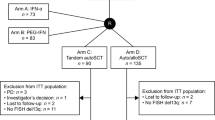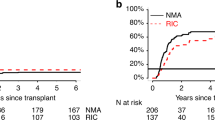Abstract
We performed a retrospective analysis of the European Group for Blood and Marrow Transplantation database comparing the outcomes of multiple myeloma patients who received tandem autologous followed by allogeneic PSCT (auto–allo) with the outcomes of patients who underwent a reduced intensity conditioning allograft (early RIC) without prior autologous transplant. From 1996 to 2013, we identified a total of 690 patients: 517 patients were planned to receive auto–allo and 173 received an early RIC allograft without prior autologous transplant. With a median follow-up of 93 months, 5-year PFS survival was significantly better in the auto–allo group, 34% compared with 22% in the early RIC group (P<0.001). OS was also significantly improved in the auto–allo group with a 5-year rate of 59% vs 42% in the early RIC group (P=0.001). The non-relapse mortality rate was lower in the auto–allo group than in the early RIC group, with 1- and 3-year rates of 8% and 13% vs 20% and 28%, respectively (P<0.001). The relapse/progression rate was similar in the two groups, with 5-year rates of 50% for auto–allo and 46% for early RIC (P=0.42). These data suggest that planned tandem autologous allograft can improve overall survival compared with upfront RIC allograft alone in patients with multiple myeloma.
This is a preview of subscription content, access via your institution
Access options
Subscribe to this journal
Receive 12 print issues and online access
$259.00 per year
only $21.58 per issue
Buy this article
- Purchase on Springer Link
- Instant access to full article PDF
Prices may be subject to local taxes which are calculated during checkout


Similar content being viewed by others
References
Maloney DG, Molina AJ, Sahebi F, Stockerl-Goldstein KE, Sandmaier BM, Bensinger W et al. Allografting with nonmyeloablative conditioning following cytoreductive autografts for the treatment of patients with multiple myeloma. Blood 2003; 102: 3447–3454.
Kroger N, Schwerdtfeger R, Kiehl M, Sayer HG, Renges H, Zabelina T et al. Autologous stem cell transplantation followed by a dose-reduced allograft induces high complete remission rate in multiple myeloma. Blood 2002; 100: 755–760.
Moreau P, Garban F, Attal M, Michallet M, Marit G, Hulin C et al. Long-term follow-up results of IFM99-03 and IFM99-04 trials comparing nonmyeloablative allotransplantation with autologous transplantation in high-risk de novo multiple myeloma. Blood 2008; 112: 3914–3915.
Rosinol L, Perez-Simon JA, Sureda A, de la Rubia J, de Arriba F, Lahuerta JJ et al. A prospective PETHEMA study of tandem autologous transplantation versus autograft followed by reduced-intensity conditioning allogeneic transplantation in newly diagnosed multiple myeloma. Blood 2008; 112: 3591–3593.
Bruno B, Rotta M, Patriarca F, Mordini N, Allione B, Carnevale-Schianca F et al. A comparison of allografting with autografting for newly diagnosed myeloma. N Engl J Med 2007; 356: 1110–1120.
Gahrton G, Iacobelli S, Bjorkstrand B, Hegenbart U, Gruber A, Greinix H et al. Autologous/reduced-intensity allogeneic stem cell transplantation vs autologous transplantation in multiple myeloma: long-term results of the EBMT-NMAM2000 study. Blood 2013; 121: 5055–5063.
Krishnan A, Pasquini MC, Logan B, Stadtmauer EA, Vesole DH, Alyea E 3rd et al. Autologous haemopoietic stem-cell transplantation followed by allogeneic or autologous haemopoietic stem-cell transplantation in patients with multiple myeloma (BMT CTN 0102): a phase 3 biological assignment trial. Lancet Oncol 2011; 12: 1195–1203.
Lokhorst HM, van der Holt B, Cornelissen JJ, Kersten MJ, van Oers M, Raymakers R et al. Donor versus no-donor comparison of newly diagnosed myeloma patients included in the HOVON-50 multiple myeloma study. Blood 2012; 119: 6219–6225.
Knop S, Liebisch P, Hebart H, Holler E, Engelhardt M, Bargou RC et al. Allogeneic stem cell transplant versus tandem high-dose melphalan for front-line treatment of deletion 13q14 Myeloma - an interim analysis of the German DSMM V trial. ASH Annu Meeting Abstr 2009; 114: 51.
Giaccone L, Storer B, Patriarca F, Rotta M, Sorasio R, Allione B et al. Long-term follow-up of a comparison of nonmyeloablative allografting with autografting for newly diagnosed myeloma. Blood 2011; 117: 6721–6727.
Crawley C, Iacobelli S, Bjorkstrand B, Apperley JF, Niederwieser D, Gahrton G . Reduced-intensity conditioning for myeloma: lower nonrelapse mortality but higher relapse rates compared with myeloablative conditioning. Blood 2007; 109: 3588–3594.
Blade J, Samson D, Reece D, Apperley J, Bjorkstrand B, Gahrton G et al. Criteria for evaluating disease response and progression in patients with multiple myeloma treated by high-dose therapy and haemopoietic stem cell transplantation. Myeloma Subcommittee of the EBMT. European Group for Blood and Marrow Transplant. Br J Haematol 1998; 102: 1115–1123.
Sahebi F, Garderet L, Iacobelli S, Biezen AV, Gahrton G, Kroger N et al. A comparison of two different reduced intensity conditioning (RIC) allograft strategies in patients with multiple myeloma. An EBMT analysis. ASH Annu Meeting Abstr 2010; 116: 3512.
Lokhorst H, Einsele H, Vesole D, Bruno B, San Miguel J, Perez-Simon JA et al. International Myeloma Working Group consensus statement regarding the current status of allogeneic stem-cell transplantation for multiple myeloma. J Clin Oncol 2010; 28: 4521–4530.
Crawley C, Lalancette M, Szydlo R, Gilleece M, Peggs K, Mackinnon S et al. Outcomes for reduced-intensity allogeneic transplantation for multiple myeloma: an analysis of prognostic factors from the Chronic Leukaemia Working Party of the EBMT. Blood 2005; 105: 4532–4539.
Bacigalupo A, Ballen K, Rizzo D, Giralt S, Lazarus H, Ho V et al. Defining the intensity of conditioning regimens: working definitions. Biol Blood Marrow Transplant 2009; 15: 1628–1633.
Ringden O, Shrestha S, da Silva GT, Zhang MJ, Dispenzieri A, Remberger M et al. Effect of acute and chronic GVHD on relapse and survival after reduced-intensity conditioning allogeneic transplantation for myeloma. Bone Marrow Transplant 2012; 47: 831–837.
El-Cheikh J, Crocchiolo R, Furst S, Stoppa AM, Ladaique P, Faucher C et al. Long-term outcome after allogeneic stem-cell transplantation with reduced-intensity conditioning in patients with multiple myeloma. Am J Hematol 2013; 88: 370–374.
Danylesko I, Shimoni A, Nagler A . Allogeneic stem cell transplantation and targeted immunotherapy for multiple myeloma. Clin Lymphoma Myeloma Leuk 2013; 13: S330–S348.
Sahebi F, Shen Y, Thomas SH, Rincon A, Murata-Collins J, Palmer J et al. Late relapses following reduced intensity allogeneic transplantation in patients with multiple myeloma: a long-term follow-up study. Br J Haematol 2013; 160: 199–206.
Rotta M, Storer BE, Sahebi F, Shizuru JA, Bruno B, Lange T et al. Long-term outcome of patients with multiple myeloma after autologous hematopoietic cell transplantation and nonmyeloablative allografting. Blood 2009; 113: 3383–3391.
Vekemans MC, Michaux L, Van Den Neste E, Ferrant A . Long-term survival after allogeneic stem cell transplantation for advanced stage multiple myeloma. Br J Haematol 2014; 166: 616–618.
Acknowledgements
We thank all participating EBMT institutions and transplant coordinators and data managers. This study was funded by the European Society for Blood and Marrow Transplantation (EBMT) Chronic Malignancies Working Party.
Author information
Authors and Affiliations
Consortia
Corresponding author
Ethics declarations
Competing interests
The authors declare no conflict of interest.
Rights and permissions
About this article
Cite this article
Sahebi, F., Iacobelli, S., Biezen, A. et al. Comparison of upfront tandem autologous–allogeneic transplantation versus reduced intensity allogeneic transplantation for multiple myeloma. Bone Marrow Transplant 50, 802–807 (2015). https://doi.org/10.1038/bmt.2015.45
Received:
Revised:
Accepted:
Published:
Issue Date:
DOI: https://doi.org/10.1038/bmt.2015.45
This article is cited by
-
Immunotherapeutic Approaches for Multiple Myeloma: Where Are We Now?
Current Hematologic Malignancy Reports (2019)
-
Allogeneic stem-cell transplantation for multiple myeloma: a systematic review and meta-analysis from 2007 to 2017
Cancer Cell International (2018)
-
Adverse impact of high donor CD3+ cell dose on outcome following tandem auto-NMA allogeneic transplantation for high-risk myeloma
Bone Marrow Transplantation (2017)



